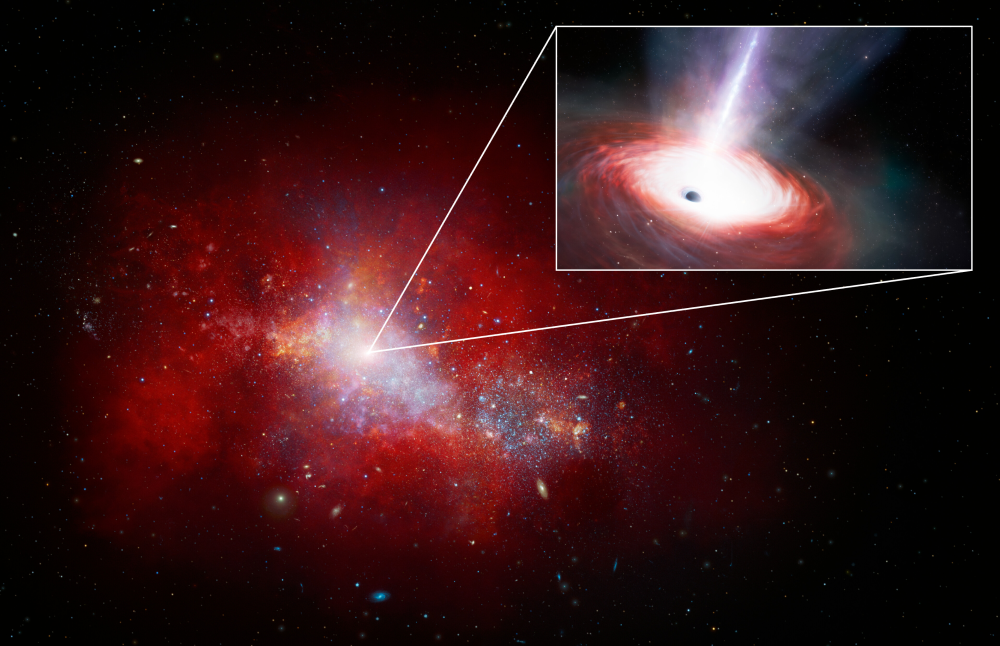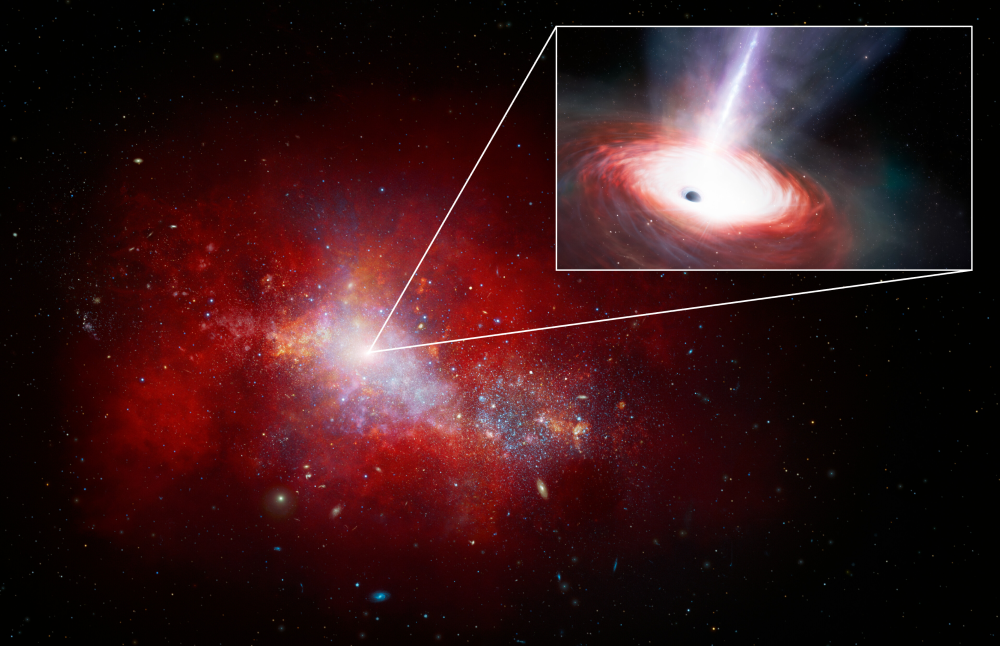Eating Without Limit: Ravenous Object May Explain Early Black Hole Growth
The Universe is filled with monstrous black holes dwelling in the center of galaxies. These supermassive black holes are millions to billions of times the size of our Sun. Surprisingly, some of these black holes are observed at great distances, corresponding to an epoch just 700 million years after the big bang. How these black holes grew so large so quickly has puzzled astronomers. New observations of the dim and dusty galaxy LID-568 with the JWST observatory show that its central black hole is consuming large quantities of matter—overcoming limits set by the outward push of radiation [1]. While more observations are needed, the study of LID-568 indicates that early black holes may undergo a “feeding frenzy” of mass accretion that allows them to reach supermassive size in a short span of time.
Supermassive black holes likely formed from “seed” black holes that grew large through mergers with other black holes or through the gradual accretion of gas. Seed black holes might have started small—with masses 10–100 times that of our Sun. However, with such a small start, it would be very difficult for these black holes to grow by a millionfold in the short time before they are observed in the early Universe. Alternatively, seed black holes could have weighed 1000–10,000 solar masses—a massive head start that potentially resulted from the collapse of extraordinarily large stars or from the direct collapse of gas clouds. However, it is not clear if such large stars or clouds exist, much less if they are plentiful enough to explain the number density of supermassive black holes observed.
One way to address the question of black hole seed size is to observe how black holes grow in their earliest stages. Hyewon Suh of the International Gemini Observatory in Hawaii and her colleagues have now captured a young black hole that appears to be experiencing an early growth spurt. They used the JWST to study a distant galaxy named LID-568 from an epoch 1.5 billion years after the big bang. LID-568 was originally detected in x rays by NASA’s Chandra X-ray Observatory, but dust heavily obscures its center, making it nearly invisible in the infrared. That is, until the JWST. “With the JWST’s incredible sensitivity in the infrared, we were finally able to uncover this exotic object,” says Suh. From the color and compactness of LID-568, Suh and collaborators infer that its emission originates not from stars but from the accretion disk around a central black hole weighing 7 million solar masses.
Accretion disks are common features around supermassive black holes, offering an explanation of the bright emission that we see from distant quasars and other so-called active galactic nuclei. The prototypical accretion disk is a thin, swirling disk of matter that circles the black hole. As disk material falls into the black hole, its gravitational potential energy is converted into heat. This heat then radiates away, exerting an outward push on material around the black hole.
But something interesting happens as more and more material falls into the black hole. The voracious black hole becomes more luminous, and at some point the outward force of radiation overcomes the inward pull of gravity. The luminosity where this happens is called the Eddington limit, and it is proportional to the mass of the black hole. Above this limit, material falling into the black hole would presumably be blown away because of the radiation pressure, shutting off the accretion that is feeding the black hole.
Astronomers can transform the luminosity limit into an accretion limit by assuming that the black hole converts a certain fraction of the infalling matter into outgoing radiation. The commonly adopted conversion factor, or “radiative efficiency,” is 10%, says Alessandro Lupi, a black hole researcher at the University of Insubria in Italy. A black hole of 7 million solar masses like the one in LID-568 would presumably be accreting at a minimum rate of 0.16 solar masses per year. But Lupi clarifies that this lower limit depends on certain parameters, such as the black hole spin and the accretion disk properties.
Indeed, the Eddington limit is not a fundamental law imposed by nature but more of a rule of thumb. It is derived from an idealized spherical model of accretion—but reality is rarely so simple. Several theories explain how black holes can exceed the Eddington limit, Suh says. For example, the accretion disk could be thicker than modelers traditionally assume, the emission could be coming out of a powerful jet, or a merger may be involved.
In the case of LID-568, the luminosity is 40 times greater than the Eddington limit, implying an accretion rate of at least 6 solar masses per year. “There have been reports of super-Eddington-accreting black holes in the nearby Universe, but with accretion rates exceeding the [Eddington] limit only by a factor of about 2 to 3,” says Suh. “LID-568 is remarkable due to its extreme growth rate and the fact that it exists so early in the Universe.”
This detection might resolve the quandary over how supermassive black holes can form both early and abundantly. “This object in LID-568 presents an alternative path of rapid growth from lower-mass seeds of stellar or primordial origin,” says Nico Cappelluti, an astronomer at the University of Miami, who was not involved in the study.
Bursts of super-Eddington accretion could explain supermassive black hole growth, but questions remain about the length of these bursts, Suh says. “Once the surrounding material is exhausted, there may not be enough gas remaining in the vicinity to sustain the same accretion rate. This would naturally limit the future growth of the black hole.”
That’s why more observations are needed, stresses Suh. Finding more of these objects can help us to have a better understanding of how common and long-lived this period of growth is. “Recent studies indicate that most accretion in the early Universe is dust obscured, suggesting that these types of objects could be quite common,” says Cappelluti.
–Elizabeth Fernandez
Elizabeth Fernandez is a freelance science writer based in Raleigh, North Carolina.
References
- H. Suh et al., “A super-Eddington-accreting black hole 1.5 Gyr after the Big Bang observed with JWST,” Nat. Astron. (2024).





